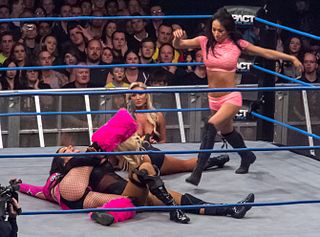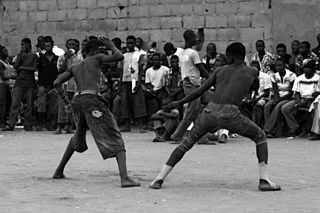Related Research Articles

Professional wrestling is a form of athletic theater that combines mock combat with drama, under the premise that the performers are competitive wrestlers. Although it entails elements of sports wrestling and martial arts, including genuine displays of athleticism and physicality before a live audience, professional wrestling is distinguished by its scripted outcomes and emphasis on entertainment and showmanship. The staged nature of matches is an open secret, with both wrestlers and spectators nonetheless maintaining the pretense that performances are bona fide competitions; this is likened to the suspension of disbelief employed when engaging with fiction, known in the industry as the aforementioned kayfabe.
Professional wrestling throws are the application of professional wrestling techniques that involve lifting the opponent up and throwing or slamming them down. They are sometimes also called "power" maneuvers, as they are meant to emphasize a wrestler's strength. Many of these moves are used as finishers by various wrestlers, who refer to them by several different names that reflect their gimmick. Moves are listed under general categories whenever possible.
Professional wrestling holds include a number of set moves and pins used by performers to immobilize their opponents or lead to a submission. This article covers the various pins, stretches and transition holds used in the ring. Some wrestlers use these holds as their finishing maneuvers, often nicknaming them to reflect their character or persona. Moves are listed under general categories whenever possible.

Collegiate wrestling, commonly referred to as folkstyle wrestling, is the form of wrestling practiced at the post-secondary level in the United States. This style of wrestling is also practiced at the high school, middle school, and elementary levels with some modifications. The rules and style of collegiate/folkstyle wrestling differ from the Olympic styles of freestyle and Greco-Roman wrestling. There are collegiate wrestling programs in almost all US states, plus Simon Fraser University in British Columbia, Canada.
A suplex is an offensive move used in sport wrestling as well as amateur wrestling and professional wrestling. It is a throw that involves lifting the opponents and bridging or rolling to slam them on their backs.

Greco-Roman, Graeco-Roman, or classic wrestling is a style of wrestling that is practiced worldwide. Greco-Roman wrestling was included in the first modern Olympic Games in 1896 and has been in every edition of the summer Olympics held since 1904. This style of wrestling forbids holds below the waist, which is the main feature that differentiates it from freestyle wrestling. This restriction results in an emphasis on throws, because a wrestler cannot use trips to bring an opponent to the ground or hook/grab the opponent's leg to avoid being thrown.

Amateur wrestling is a variant of wrestling practiced at Olympic, collegiate, scholastic, and other levels. There are two international wrestling styles performed at the Olympic Games, freestyle and Greco-Roman, both of which are governed by the United World Wrestling (UWW).
Strikes can be offensive moves in professional wrestling, that can sometimes be used to set up an opponent for a hold or for a throw. There are a wide variety of strikes in pro wrestling, and many are known by several different names. Professional wrestlers frequently give their finishers new names. Occasionally, these names become popular and are used regardless of the wrestler performing the technique.

Freestyle wrestling is a style of wrestling. Along with Greco-Roman, it is one of two styles of wrestling contested in the Olympic Games. High school wrestling and men's collegiate wrestling in the United States are conducted under different rules and termed scholastic and collegiate wrestling. U.S. collegiate women's wrestling is conducted under freestyle rules.

In professional wrestling, a pin is a move where a wrestler holds an opponent's shoulders to the mat in an attempt to score a fall. A pinfall is a common victory condition, where the attacker pins an opponent and the referee makes a three count before the opponent gets released from the pin.

Arm wrestling is a sport with two opponents who face each other with their bent elbows placed on a table and hands firmly gripped, who then attempt to force the opponent's hand down to the table top. The sport is often casually used to demonstrate the stronger person between two or more people. Arm wrestling is an ancient sport that was revived in the 1950s in the United States. In September 1962, the first world wrestling championship was held in Petaluma, California, as this wrestling was called.

Gouren is a style of folk wrestling which has been established in Brittany for several centuries. It is practiced mainly in Brittany, but also in some neighboring regions, in particular through international meetings organized by the FILC, for example in Cornwall, in Scotland and a Gouren skol has opened in New Orleans, in the United States.

A dropkick is an attacking maneuver in professional wrestling. It is defined as an attack where the wrestler jumps up and kicks the opponent with the soles of both feet; this sees the wrestler twist as they jump so that when the feet connect with the opponent one foot is raised higher than the other and the wrestler falls back to the mat on their side, or front. This is commonly employed by light and nimble wrestlers who can take advantage of their agility, and is often executed on a charging opponent, while charging at an opponent, or a combination of the two.

Mongolian wrestling, known as Bökh, is the folk wrestling style of Mongols in Mongolia, Inner Mongolia and other regions where touching the ground with anything other than a foot loses the match. Bökh means "firmness, reliability, vitality, wrestler", from Mongolic root *bekü "firm, hard, solid; fighter, strong man" possibly from Turkic *böke "warrior" < "Dragon". Wrestling is the most important of the Mongolian culture's historic "Three Manly Skills", that also include horsemanship and archery. Genghis Khan considered wrestling to be an important way to keep his army in good physical shape and combat ready. The court of the Qing dynasty (1646–1911) held regular wrestling events, mainly between ethnic Manchu and Mongol wrestlers. There are several different versions, Mongolian, Buryatian, Oirat and Inner Mongolian.

Scholastic wrestling, sometimes referred to as folkstyle wrestling and commonly known as simply wrestling, is a style of amateur wrestling at the high school and middle school levels in the United States. It has often been labeled the "toughest sport in the world" because of the extensive physical conditioning, mental preparation, complexity, and intense nature of its one-on-one competition, which requires physical power, speed, quick mental processing and reaction, and enormous preparation.
Kimarite is the technique used in sumo by a rikishi (wrestler) to win a match. It is officially decided or announced by the gyōji (referee) at the end of the match, though judges can modify this decision. The records of kimarite are then kept for statistical purposes.

Collar-and-elbow wrestling is a martial art and form of jacket wrestling native to Ireland. Historically it has also been practised in regions of the world with large Irish diaspora populations, such as the United States and Australia.
Scottish Backhold is a style of folk wrestling originating in Scotland. The wrestlers grip each other around the Chest and shoulders at the back, with the right hand under the opponent's left arm and left arm over. With the chin resting on the opposite right shoulder and an S-Grip hold. The bout is controlled by a central referee and two judge's all of equal standing. Falls are decided by a majority of three rule, with no conferring. When the referee is sure that both wrestlers have taken a firm grip, he shouts "HOLD" and the bout starts. Should either wrestler break his hold or touch the ground with any part of his body except the soles of their feet, he/ she loses. If both wrestlers hit the ground or mat at the same time a "Dog Fall" is declared and the fall is wrestled again immediately. There is no ground work and the bouts are usually best of five falls.

Dambe is a martial art of the Hausa people from Nigeria. Competitors in a typical match aim to subdue each other into total submission mostly within three rounds. It often results in serious bodily injury. Boxers are called by the Hausa word "daæmaænga".
The following words are terms used in sumo wrestling in Japan.
References
- ↑ The Smallest Richest Nation Ebony, May 1968, p118
- ↑ Up front with the editor Pacific Islands Monthly, March 1968, p10
- 1 2 3 4 5 Alois Kayser (2005) Nauru One Hundred Years Ago: Volume 3: Games & Sports p23